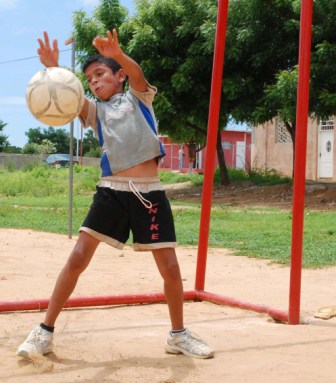My Friends from Happy Town
Caridad

It wasn’t in my plans to stop at this place; the noontime heat here is as intense as in Cuba. Indeed, Maracaibo, Venezuela is as hot as Santiago de Cuba. However, the car I was in thought that it was time to stop and cool its engine.
Under a group of trees were several tables at which were sitting several boys and girls with chess boards in front of them. I don’t care for chess, but I went over to the kids to steal some of the cool air from the trees.
There was no reticence in their looks, and from the kids came smiles and greetings. People have told me that people from Maracaibo seem a lot like Cubans, and that seems to be so, because in less than five minutes another group of children —a soccer ball among them— took me over to a small field and we begin kicking the ball around.
I chased behind the ball with the same joy as when I was 10 or 12. They were not bothered in asking me where I was from; they only whispered and laughed among themselves at my strange way of talking.

Daniel preferred to be the goalkeeper; he was good at that. But when the other ones saw that I was taking pictures of him, they suddenly preferred that position too. So, it was better to organize a penalty kick, that way all of them could appear in the photo.
A “kikimbol” game was about to begin and we had to leave the field. Kikimbol is like baseball, except there’s no bat and a soccer ball is used instead.
Three of the teens asked me to take pictures of them as well, though they weren’t playing with me then, they said they had been playing a half hour earlier.
Two little girls, from those who had been learning how to play chess, wanted to find out what was hanging from my neck, what type of bird it was. They wanted their pictures taken as well including a photo of the three together.
They also wanted me to stay a little while longer to play with them, or that I come back the next day, because every day in this neighborhood known as Villa Feliz (Happy town), they leave their homes to learn new games or simply to run after a ball. This is because they’re children, and that’s what children usually do.
Click on the tumbnails below to view all the photos in this gallery




















There is a new game that was invented in Santa Monica, California to allow young field soccer players to keep up and develop their soccer skills in the off-season. It’s invention came from a novel. It’s like “kikimbol,” but more complex.
It’s called “soccerball” in English or “soquerbol” in Spanish. In this game a baseball or softball diamond is used, but a soccer goal is positioned in both left and right fields. Each goal has a goalkeeper.
Each team has 10 “primary” players plus up to six substitutes. Each team must have an equal number of substitutes per game, and all players get to “bat” each inning. There are three innings.
The team players “in the field” rotate backwards from dugout to catcher, to pitcher, to first base, and so on, after each “batter” kicks the ball. The right field goalkeeper comes into the dugout after each “bat” and rotates back through the field positions until all the players in the team “in town” have “batted.”
There are no strike-outs. Every player in town gets to kick the ball and run. The pitcher pitches from the mound according to soccer “throw-in rules.” The ball bounces once an comes over the plate.
A batter can either kick the ball into the field and run the bases, or receive the ball per soccer rules and drive through the infield toward a goal. The only infielders able to intercept such a runner is one of the two shortstops. If the runner gets past the shortstop, she or he can then drive on the goal and shoot. If a goal is not made on the first shot, the runner must get to first base before the ball or the out is made.
Field players may catch the ball by hand, but can pass only with a foot or by the forehead. Baseball/softball rules apply as much as possible.
If a runner is on base and the ball is not under control by the team in the field, the runner may “sea gull” the ball, that is, take control of it–like a sea gull dropping down suddenly from the sky–and drive on a goal and shoot. If a seaguller shoots and misses, she or he must return to the abandoned base before the ball gets to the base player, or the runner is out.
Soquerbol is fast paced and high scoring, like basketball. It can really get exciting, especially when a runner drives toward a goal from home base or sea gulls from a base. It would be interesting to see the game played in Cuba.
Good job, Yordanka.
Funny . . . These people don’t look as though they’re having a horrible life! But they obviously are, because look: the government if forcing the kids to play chess and soccer, and to smile and wave for the camera!